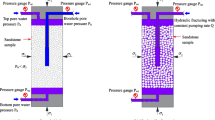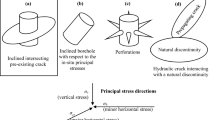Abstract
We carried out hydraulic fracturing tests in hollow cylinders of Tablerock sandstone subjected to vertical (σ ν ), confining (σ h ) and pore (P o ) pressures. Borehole fluid was injected at a constant flow rate until a peak pressure was reached, and vertical fracture was observed. Based on the analysis of pressure-time records, we submit that breakdown occurs before peak pressureP p in the first cycle. In a series of tests in which σ h , σ ν , andP 0 were kept constant throughout, breakdown pressureP c increased significantly with wellbore pressurization rate, and appeared to asymptotically approach to an upper and lower bound corresponding to fast and slow rates, respectively as expected by Detournay and Cheng (1992). Another series of tests conducted at a preset pressurization rate in unjacketed specimens (σ h =P o ) revealed that (P c -P o ) increased with confining/pore pressure, contrary to the constant (P c -P o ) based on the Terzaghi’s effective stress law. We modified the Detournay-Cheng criterion by replacing the Terzaghi’s effective stress with a general effective stress. More series of hydraulic fracturing tests in jacketed specimens reinforced the applicability of the modified Detournay-Cheng criterion to Tablerock sandstone in terms of correctly estimating the relationship between the unknown far-field stress and the typically known test parameters: breakdown pressure, initial pore pressure and pressurization rate.
Similar content being viewed by others
References
Abou-Sayed, A.S., Brechtel, C.E. and Clifton, R.J., 1978, In situ stress determination by hydrofracturing: a fracture mechanics approach. Journal of Geophysical Research, 83, 2851–2862.
Biot, M.A. and Willis, D.G., 1957, The elastic coefficients of the theory of consolidation. Journal of Applied Mechanics, 24, 594–601.
Detournay, E. and Carbonell, R., 1994, Fracture mechanics analysis of the breakdown pressure in minifrac or leak-off test, In Proceedings of Eurock ’94, SPE/ISRM Rock Mechanics in Petroleum Engineering, Rotterdam: Balkema, p. 399–407.
Detournay, E. and Cheng, A., 1992, Influence of pressurization rate on the magnitude of the breakdown pressure. In: Tillerson and Wawersik, W.R. (eds.), Rock Mechanics, Rotterdam, Balkema, p. 325–333.
Griffith, A.A., 1921, The theory of rupture. Proceedings of the 1st International Congress of Applied Mechanics, p. 56–63.
Haimson, B.C., 1980, Near surface and deep hydrofracturing stress measurements in the Waterloo quartzite. International Journal of Rock Mechanics and Mining Sciences & Geomechanics Abstracts, 17, 81–88.
Haimson, B.C. and Fairhurst, C., 1967, Initiation and extension of hydraulic fractures in rocks. Society of Petroleum Engineering Journal, 7, 310–318.
Haimson, B.C. and Zhao, Z., 1991, Effect of borehole size and pressurization rate on hydraulic fracturing breakdown pressure. In: Roegiers, J.-C. (ed.), Rock Mechanics as a Multidisciplinary Science, Rotterdam, Balkema, p. 191–199.
Hickman, S. and Zoback, M.D., 1983, The interpretation of hydraulic fracturing pressure. time data from in situ stress determination. In: Hydraulic Fracturing Stress Measurements, National Academy Press, Washington, D.C., p. 44–54.
Hubbert, M.K. and Willis, D.G., 1957, Mechanics of hydraulic fracturing. Transactions of American Institute of Mining Engineering, 210, 153–168.
Inglis, C.E., 1913, Stresses in a plate due to the presence of cracks and sharp corners. Transactions of Institute Naval Architects, LV, 219–230.
Ito. T. and Hayashi, K., 1991, Physical background to the breakdown pressure in hydraulic fracturing tectonic stress measurements. International Journal of Rock Mechanics and Mining Sciences & Geomechanics Abstracts, 28, 285–293.
Jaeger, J.C., 1963, Extension failures in rocks subjected to fluid pressure. Journal of Geophysical Research, 68, 6066–6067.
Jaeger, J.C. and Cook, N.G.W., 1963, Pinching-off and disking of rocks, Journal of Geophysical Research, 68, 1759–1765.
Lee, M.Y. and Haimson, B.C., 1989, Statistical evaluation of hydraulic fracturing stress measurement parameters. International Journal of Rock Mechanics and Mining Sciences & Geomechanics Abstracts, 26, 447–456.
Prothero, D.R. and Schwab, F., 1966, Sedimentary Geology: An Introduction, to Sedimentary Rocks and Stratigraphy. W.H. Freeman, New York, 575 p.
Rummel, F. and Winter, R.B., 1983, Fracture mechanics as applied to hydraulic fracturing stress measurements. Journal of Earthquake Prediction Research, 2, 33–45.
Schmitt, D.R. and Zoback, M.D., 1989, Poroelastic effects in the determination of the maximum horizontal principal stress in hydraulic fracturing tests a proposed breakdown equation employing a modified effective stress relation for tensile failure. International Journal of Rock Mechanics and Mining Sciences & Geomechanics Abstracts, 26, 439–506.
Schmitt, D.R. and Zoback, M.D., 1992, Diminished pore pressure in low-porosity crystalline rock under tension failure: apparent strengthening by dilatancy. Journal of Geophysical Research, 97, 273–288.
Song, I. and Haimson, B.C., 2000, Hydraulic fracturing experiments in highly porous Bern sandstone. In: Girard, J., Liebman, N.I. Breed, C. and Doe, T. (eds.), Pacific Rocks 2000, Rotterdam, Balkema, p. 1185–1192.
Song, I. and Haimson, B.C., 2001, Effect of pressurization rate and initial pore pressure on the magnitude of hydrofracturing breakdown pressure in Tablerock sandstone, The 38th U.S. Rock Mechanics Symposium, July 7–10, Washington D.C. (submitted)
Terzaghi, K., 1943, Theoretical Soil Mechanics. Wiley, New York, 510 p.
Whitney, J.M. and Nuismer, R.J., 1974, Stress fracture criterion for laminated composites containing stress concentration. Journal of Composite Materials, 8, 156–165.
Wood, S.H. and Burnham, W.L., 1987, Geologic framework of the Boise Warm Springs geothermal area, Idaho. In: Beus (ed.), Rocky Mountain Section of the Geological Society of America Centennial Field Guide. Geological Society of America, Boulder, p. 117–122.
Zoback, M.D., Tsukahara, H. and Hickman. 5., 1980, Stress measurements near the San Andreas fault, Journal of Geophysical Research, 85, 6157–6173.
Author information
Authors and Affiliations
Corresponding author
Rights and permissions
About this article
Cite this article
Song, I., Suh, M., Won, K.S. et al. A laboratory study of hydraulic fracturing breakdown pressure in tablerock sandstone. Geosci J 5, 263–271 (2001). https://doi.org/10.1007/BF02910309
Received:
Accepted:
Issue Date:
DOI: https://doi.org/10.1007/BF02910309




